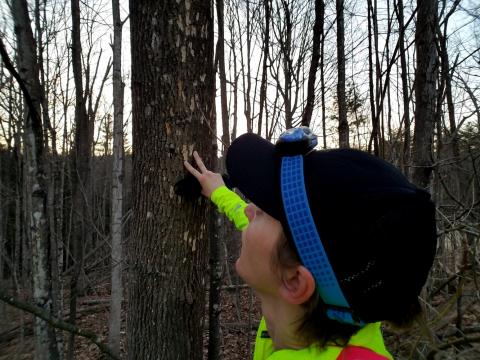When It’s OK to Look into Your Neighbors’ Yards

My neighbors probably think I’m spying on them. And with good reason. I kind of am. You see, I’ve been staring into their yards when I’m out for a run in the neighborhood. “Why?,” you might ask. And, why am I admitting this? To answer the first question, because I’m looking for signs of emerald ash borer. And, to answer the second question, because I want you to do it, too.
If you have ash trees in your yard, like I do, you might be concerned about finding them infested with emerald ash borer. I’m concerned, especially because about a year ago a couple trees on a main road not far from my home were diagnosed with this nasty invasive pest.
The nearby ash trees that are infested are very easy to spot. They have bark that looks blond, or lighter in color than usual ash bark. This “blonding”—what we call it in the forest health community—is a result of woodpeckers chipping away at the bark to find emerald ash borer larvae that live protected under the bark until they emerge as adult beetles.
Right now, in the spring before the leaves emerge on the trees, is a very good time to look for signs of emerald ash borer as you’re walking, running or cycling through your neighborhood. How do you do it?
- First, make sure you’re looking at an ash tree! Ash trees have pretty distinctive bark, what I’ve heard referred to as “cantaloupe-like” on mature trees. Another thing to look for is opposite branching. Do the twigs on a branch sit side-by-side, like your arms? Ash trees are one of the few trees with opposite branching.
- Then, look for blonding on the trunk. It will just appear as a light scarring of the bark. Deep holes into the tree are not indicative of emerald ash borer. Check out this resource for more tips.
- If leaves are starting to emerge, look to the top of the tree. Does the growth look sparse at the very top? Ash trees infested with emerald ash borer tend to die from the top down.
- If any of the bark has peeled away, look for S-shaped tracks in the tree, known as galleries. Larvae form these galleries as they develop.
- If you find anything suspicious, take a few pictures and upload them at https://nhbugs.org/invasive-insect-reporting-form.
Also, a word of caution. It is rare that landowners actually see an emerald ash borer adult. You especially will not see them in April or May. If you’re seeing bright green beetles running around on the ground in early May, it’s likely a six-spotted tiger beetle. They are very common—and very fast—ground-dwelling beetles. The adult emerald ash borers don’t emerge until June, and they tend to stay in the trees!
If your neighbors ask what you’re doing, TELL THEM! We need as many eyes on the trees as we can get. Happy spying, I mean, observing!

